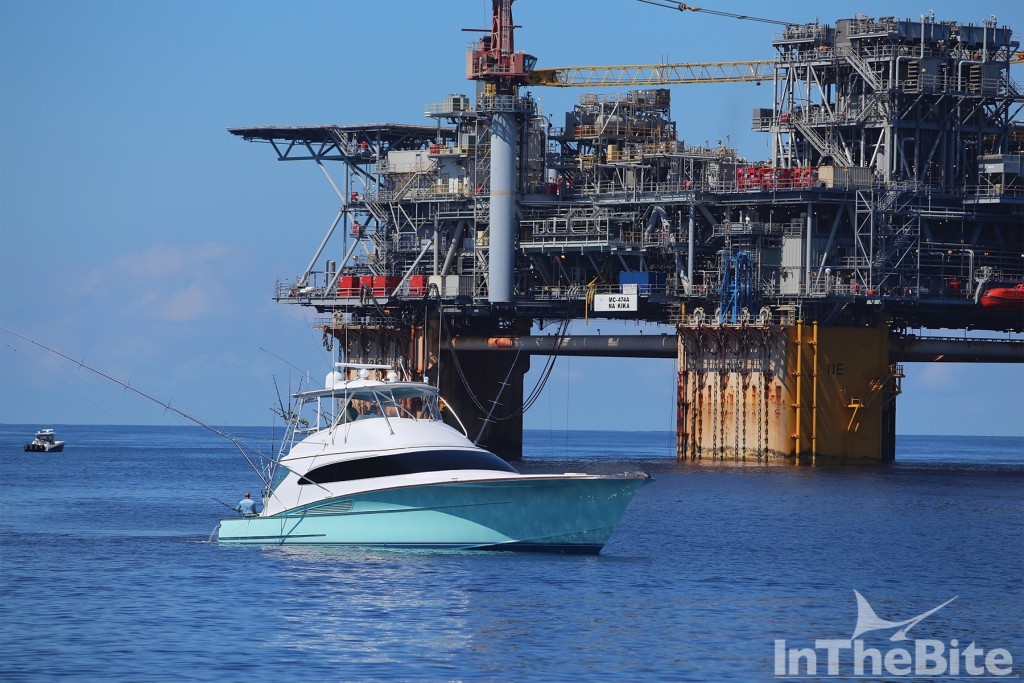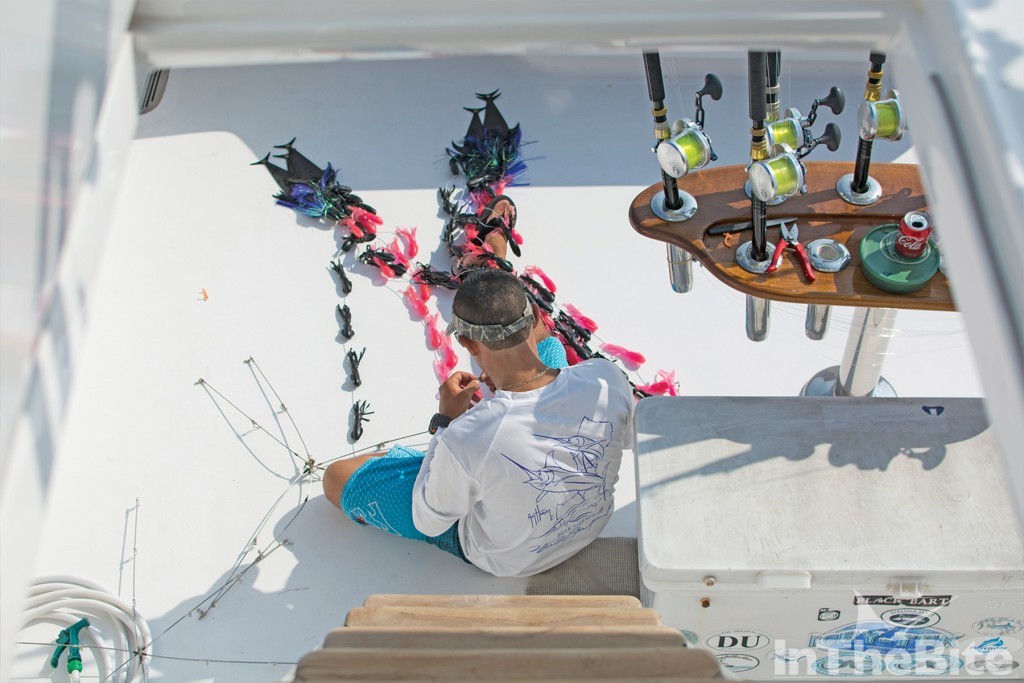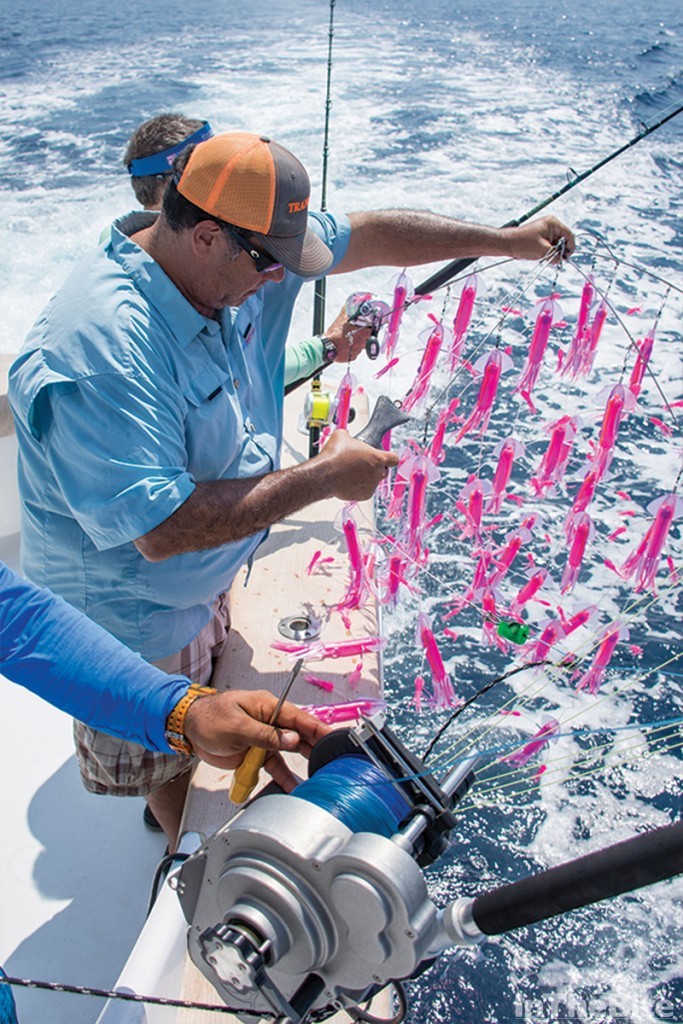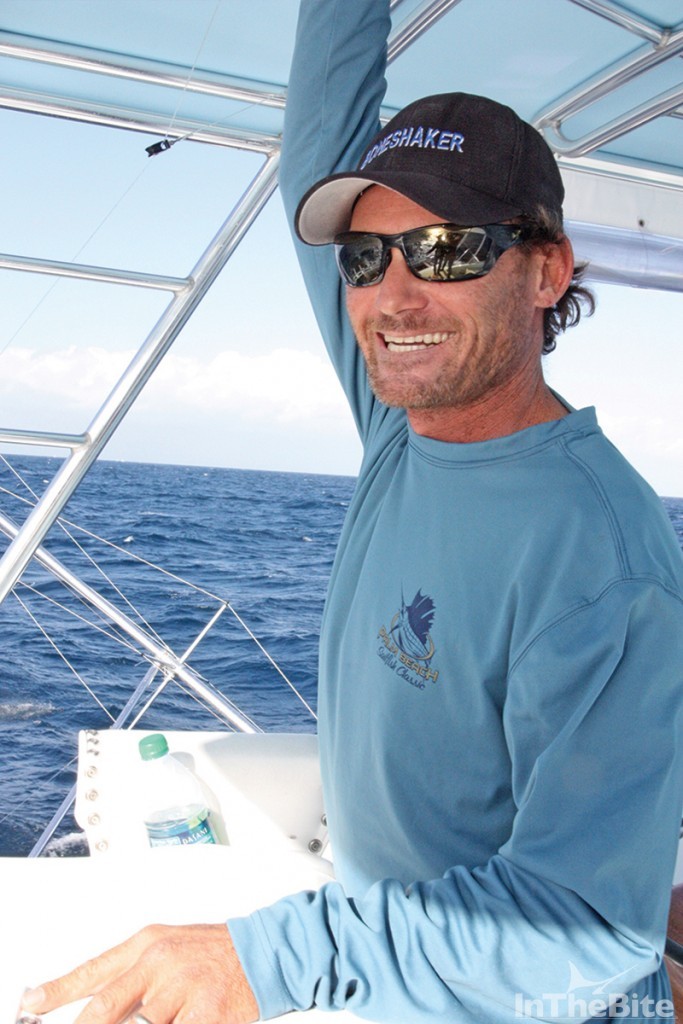The first time I saw a marlin dredge I had two thoughts. First: that looks ridiculous. Second: that looks awesome! At first, 40 rigged mullet dangling from a web-work of bars and leader looks like a cluster FUBAR waiting to happen. Put the dredge in the water, and dozens of swirling and flashing baits look like a school of bait on the run. Fish cannot resist. Many anglers had the same experience when they first saw a dredge. We caught up with five pros to find out how they use dredges now, and how they plan to use them in the future.
Captain John Bayliss, Tarheel
When Captain John Bayliss first saw a dredge he knew he had to have one. I was fishing in Mexico and getting sacked up, he laughs. Then he spotted the mate on the other boat pull in a four bar single dredge rigged with jumbo mullet. It was super simple, he recalls, that was before building dredges became a nuclear arms race.
In 20 years fishing with dredges all over the world and at home on the Outer Banks, Captain Bayliss has gone full circle. We had a dredge we called the Space Shuttle, he chuckles. The four-level dredge was followed by spreader bars and two chains. The chains looked like booster rockets, he jokes.
 Now he has settled on a dredge system that is simple and effective. A good dredge is double or triple bars, he says. He adds a skirt to every other bait for more body and flash. Bayliss has found that adding artificial rubber fish or Marlin Mudflaps gives the dredge more density. Mudflaps are rubber fish silhouettes that mimic a fleeing tuna. Color of artificials and skirts depends on location and conditions. On the East Coast, Bayliss likes blues and blacks, in the Pacific he uses bright pink and red. He especially likes artificials on blue marlin dredges. Blue marlin move so fast, they are just looking for something with mass.
Now he has settled on a dredge system that is simple and effective. A good dredge is double or triple bars, he says. He adds a skirt to every other bait for more body and flash. Bayliss has found that adding artificial rubber fish or Marlin Mudflaps gives the dredge more density. Mudflaps are rubber fish silhouettes that mimic a fleeing tuna. Color of artificials and skirts depends on location and conditions. On the East Coast, Bayliss likes blues and blacks, in the Pacific he uses bright pink and red. He especially likes artificials on blue marlin dredges. Blue marlin move so fast, they are just looking for something with mass.

Photo courtesy Jack Snow.
Captain Joe Birbeck, You Never Know
Dredge fishing started in Mexico almost 20 years ago. That when Captain Joe Birbeck first saw one of these contraptions. I saw a guy on the dock with a dredge and I went right out and got the stuff to make one, he says.
Since then, Birbeck has fished dredges from the Atlantic to the Pacific and at home on the Gulf Coast. In that time, he seen dredge technology change. It hard to believe old-school guys still use floss to rig their dredge baits, he shakes his head. The invention of reusable pin rigs has made it easier to rig natural baits.
Birbeck has also seen more artificial baits in his dredge. I know old-school guys might not agree, he admits, but adding Marlin Mudflaps and Fire Tailz saves time and money. Fire Tailz are jointed fish silhouettes made out of fabric. Supplementing some of the natural baits with artificial baits gives the dredge more lift. Adding artificials to the dredge also helps level the dredge so it swims parallel to the surface.
In Mexico, Birbeck uses a double mullet or double ballyhoo dredge. Weve fished artificial dredges side-by-side with the natural dredges and raised just as many fish, he admits. In the Gulf, when he finds the fish, he bumps up to a three-tier dredge. We do a lot of high-speed trolling to find the marlin, he explains, but once we have them cornered well use the dredge. When he live bait fishing, Birbeck deploys a six-arm dredge armed with Mudflaps. It looks like a school of blackfin tuna, he explains.
 Birbeck likes to dredge behind the flatlines and the squid chain behind the dredge. He starts the day with his go-to colors. If were not raising fish by lunch, well switch up colors and start experimenting.
Looking into the future, Birbeck expects artificial dredge baits to become more life-like. It amazing how far dredges have come, he marvels, from spoons and hook-less Rapalas to rubber shads and fish. Recently, he noticed hard-plastic dredge baits showing up on the dock. In 25 years, Ive never stopped experimenting, he says, Im always learning.
Birbeck likes to dredge behind the flatlines and the squid chain behind the dredge. He starts the day with his go-to colors. If were not raising fish by lunch, well switch up colors and start experimenting.
Looking into the future, Birbeck expects artificial dredge baits to become more life-like. It amazing how far dredges have come, he marvels, from spoons and hook-less Rapalas to rubber shads and fish. Recently, he noticed hard-plastic dredge baits showing up on the dock. In 25 years, Ive never stopped experimenting, he says, Im always learning.
Captain Scott Fawcett, offthechainfishing.com
Captain Scott Fawcett started dredge fishing in the mid-nineties while working with Captain VJ Bell on Boneshaker. My favorite was a four-arm with 11 mullet, he reminisces. From there, dredges and dredge fishing got bigger. We ended up using three-tier dredges with dozens of baits, he says, it got to the point where it was too much money and effort. Now he settles on a simpler dredge set-up that he can manage. When fishing is slow, we add a trailer that the fish can suck on, he jokes. When the action picks up, he removes the dropper. I dont want the fish to pick out a single bait, he explains, instead I want it to move off to the flat line or long rigger. He has also started removing his squid-chain teasers from the water when the fish are skittish. Ive found that the teaser can turn them off, he says. Dredge fishing is so effective that Fawcett also employs them on his center console. When he drifting live baits off South Florida, he likes to sink a Stripteaser. This artificial teaser uses holographic fish on a strip of clear plastic film that undulates in the water. It light and easily affected by the movement of the boat and current. When the current and wind are too light for drift fishing, he slow trolls at 1.5 to 2.5 knots using two dredges armed with artificial fish. The sailfish really lock onto the paddletails, he says.

Photo courtesy Pepper Ailor
 To test the effectiveness of his dredges, he watches the fish it attracts. If the fish is stuck on the dredge, I know it is working, he explains. Hell leave a fish on the teasers as long as possible. Nothing attracts fish better than another fish. Fawcett loves to watch marlin attack the teasers. If marlin fishing wasnt waiting for the pin to snap and yelling, ˜There he is! I wouldnt do it for a living. He geeks out on the visuals. The only thing that would be better is if marlin could roar like a lion, he laughs.
To test the effectiveness of his dredges, he watches the fish it attracts. If the fish is stuck on the dredge, I know it is working, he explains. Hell leave a fish on the teasers as long as possible. Nothing attracts fish better than another fish. Fawcett loves to watch marlin attack the teasers. If marlin fishing wasnt waiting for the pin to snap and yelling, ˜There he is! I wouldnt do it for a living. He geeks out on the visuals. The only thing that would be better is if marlin could roar like a lion, he laughs.
Bill Pino, squidnation.com
As owner of Squidnation, Bill Pino has made a study of dredge history and trends. His squid dredges revolutionized teaser technology by adding artificial baits to natural teasers.
The first time I used a dredge was on Pelican with Captain Arch Bracher, he remembers. They were fishing a weed line off Hatteras and Bracher deployed a single dredge with large mullet. We raised a blue marlin, then caught a white and a blue pretty quickly.
Pino was sold on dredges, but it wasnt until another captain suggested using his artificial squids on the dredge that Pino saw the full potential. We fished artificial squid dredges all summer and ended up with the most releases out of Ocean City, he beams, when I told people they laughed at me.
Since then, Pino has continued to experiment and refine his dredges. He went from single droppers to chain style dredges and adjusted leader distance to keep the squids from tangling. We noticed the fish were on small baits in Costa Rica so we came up with a dredge that uses 108 small squid, he says, it looks like a big ass bait ball.
 One advantage he noticed is that fish tend to move off of an artificial dredge faster than from natural baits. The fish hits a natural bait and hell keep at it until he gets it off the dredge, he says. With an artificial dredge, the fish tend to hit the rubber bait once then move off to the squid chain or one of the hook baits.
To learn more about dredge technology and techniques, Pino takes input from anglers and captains. I see guys dropping dredges back farther and farther, he says. Improved lead weights that can be adjusted for the perfect presentation make it possible to place the dredge anywhere in the spread. He has seen some crews go to the extreme of adding heat shrink to the dredge arms to deaden the sound.
One advantage he noticed is that fish tend to move off of an artificial dredge faster than from natural baits. The fish hits a natural bait and hell keep at it until he gets it off the dredge, he says. With an artificial dredge, the fish tend to hit the rubber bait once then move off to the squid chain or one of the hook baits.
To learn more about dredge technology and techniques, Pino takes input from anglers and captains. I see guys dropping dredges back farther and farther, he says. Improved lead weights that can be adjusted for the perfect presentation make it possible to place the dredge anywhere in the spread. He has seen some crews go to the extreme of adding heat shrink to the dredge arms to deaden the sound.













